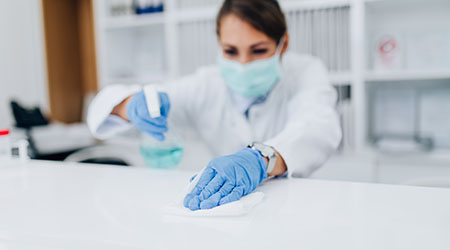Editor’s note: This is the second part of a two-part column. Read part one here.
Environmental surfaces abound in every indoor environment. Those environmental surfaces get loaded with fomites — nonliving material, any object or substance, other than food, that harbors or carries infectious organisms. As environmental services staff goes about the daily routine of spraying and wiping, managers might wonder, “Are those surfaces being cleaned and disinfected the right way? What confidence do I have that the processes, training, tools, and chemicals are delivering the best outcome: a safe, clean and disinfected space?”
Here are some factors that impact the ability to consistently deliver on a promise that the building will be safer because the process, products and people work as they should:
- Method of applying cleaners and disinfectants — spray bottle vs. bucket; mop and bucket vs. microfiber mop
- Not enough time allowed for thorough cleaning
- Cleaners using the wrong tools (cotton rags vs. microfiber)
- No formal program for testing cleaning efficacy.
Application insights
Without going into detail, it is a violation of the Occupational Safety and Health Administration’s general duty clause — What would a prudent person do? — to dispense disinfectants with a trigger sprayer. When the disinfectant is aerosolized, it can be inhaled into the worker’s lungs and become a chronic, occupational risk to housekeepers and custodians. The same thing could be said about all cleaning chemicals. For that reason alone, a prudent person would get rid of trigger sprayers on all cleaning chemicals, especially disinfectants.
Beyond the risk of spraying disinfectants and cleaning chemicals, there is the issue of how long the surface remains wet with a spray-and-wipe method. The surface needs to remain wet with disinfectant for at least 60-90 seconds, according to the Centers of Disease Control and Prevention, regardless of the dwell time on the product’s label. With the so-called spray- and-pray method, that is very difficult to attain.
A 60-90 second dwell time is much easier to attain if using the bucket-and-cloth method of applying disinfectants and cleaners. With a wetter surface, general-purpose cleaners also have a better chance of emulsifying and lifting soil from the surface.
Time matters
Next, let’s look at the amount of time allotted to complete cleaning tasks. A detriment to the proper cleaning of environmental surfaces might be the fact that the environmental services aide has not been given enough time to complete the task. There are great resources from Association for the Health Care Environment for benchmarking time to task. If given a bucket of disinfectant or general-purpose cleaner and the correct amount of time to do the job, does the cleaning staff have the right tools for soil removal?
My other question is, are employees still using cotton rags, or do they have microfiber wipers? Cleaning professionals have switched from cotton terrycloth rags to high denier microfiber for maximum soil removal with minimum effort.
Microfiber helps physically remove the food and moisture that microorganisms need to survive, but better grades of microfiber — those with very dense weaving and fiber configuration — can even remove large quantities of microbes, including hard-to-kill spores. Workers can use microfiber with a disinfectant solution in bucket for best results against germs.
How clean is clean?
The final piece of the puzzle called, “Are we cleaning environmental surfaces the right way?” is one called measuring clean. For too long, clean has been a subjective term that is determined by a simple visual assessment. Two people inspecting the same room or the same object might have different opinions about whether it passes the test.
More people are augmenting or enhancing the visual inspection approach with rapid testing technologies and interventions, including educating, training and better equipping the cleaning staff. If managers start testing for cleanliness and sharing that information with staff, they can move them from saying, “I believe it is clean” to “I have taken measurements that help prove that it is clean.”
Those seeking evidence are using handheld meters that test surfaces for adenosine triphosphate (ATP), which is the energy molecule inside all living cells. ATP is found in bacteria, mold, fungus, and other organic matter that provide a rich food source for pathogens. ATP measurement has been used in food processing for years, but until now, the cleaning industry lacked precise, portable, and cost-effective devices. ATP meters provide feedback in less than 30 seconds and enable cleaning professionals to verify how clean surfaces are with respect to organic matter.
Hopefully, managers have been making a checklist of things they need to do to ensure that staff are cleaning and disinfecting environmental surfaces the right way, and they can prove it.
J. Darrel Hicks, BA, MESRE, CHESP, Certificate of Mastery in Infection Prevention, is the past president of the Healthcare Surfaces Institute. Hicks is a nationally recognized subject matter expert in infection prevention and control as it relates to cleaning. He is the owner and principal of Safe, Clean and Disinfected. His enterprise specializes in B2B consulting, webinar presentations, seminars and facility consulting services related to cleaning and disinfection. He can be reached at darrel@darrelhicks.com. Learn more at www.darrelhicks.com.

 Designing Healthcare Facilities for Pediatric and Geriatric Populations
Designing Healthcare Facilities for Pediatric and Geriatric Populations Kaiser Permanente Announces New Hospital Tower at Sunnyside Medical Center
Kaiser Permanente Announces New Hospital Tower at Sunnyside Medical Center Building Disaster Resilience Through Collaboration
Building Disaster Resilience Through Collaboration Amae Health Expands to New York City
Amae Health Expands to New York City Hospital for Special Surgery Opens Two New Facilities in New Jersey
Hospital for Special Surgery Opens Two New Facilities in New Jersey